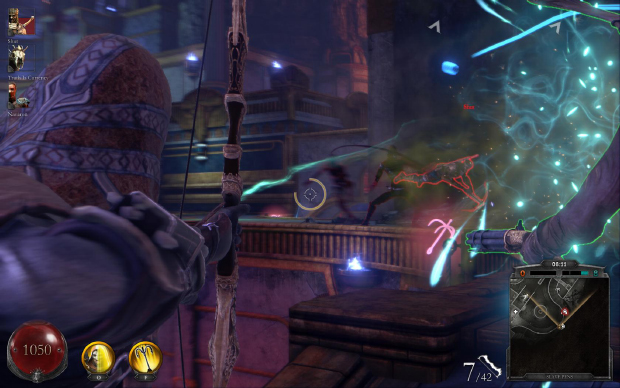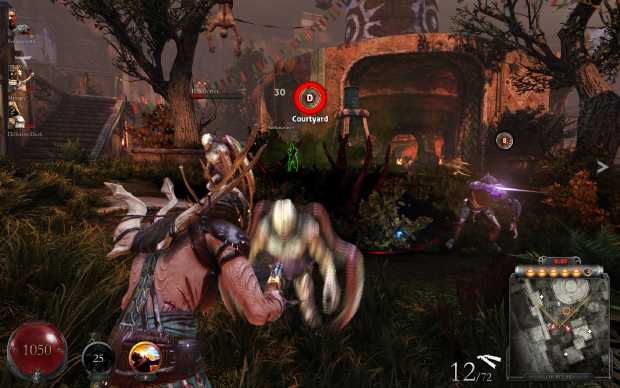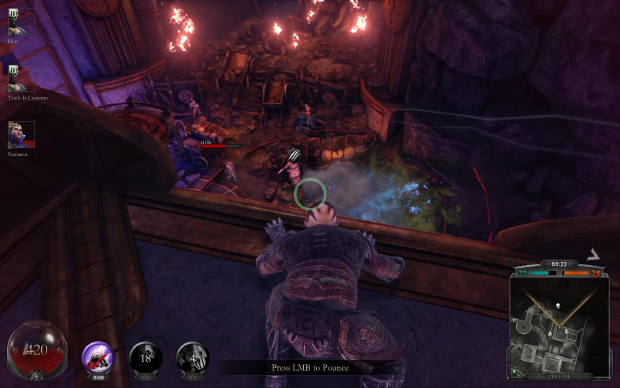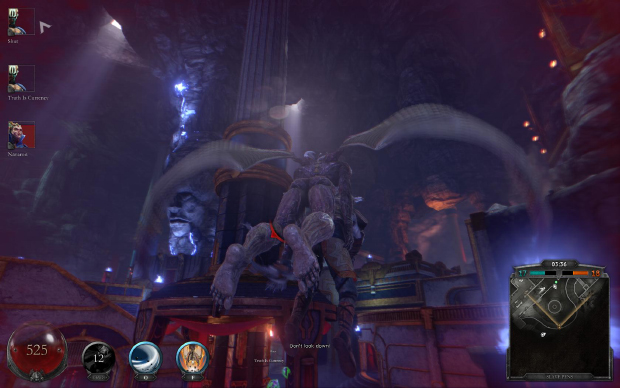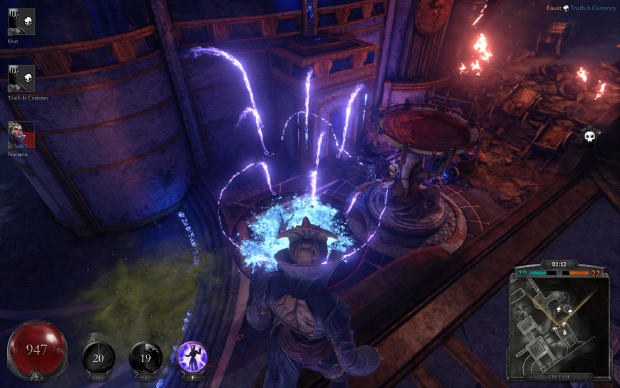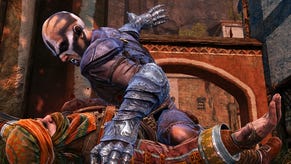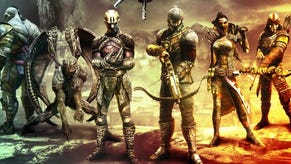Premature Evaluation: Nosgoth
Vein glorious?
Each week Marsh Davies sinks his teeth into the hot, pumping artery of Early Access and drains its sweet lifegiving essence, leaving only a ragged skein of flesh when he’s done. This week he’s played (or free-to-played) Nosgoth, a team-based multiplayer game in which heavily-armed non-consenting blood-donors clash with the fanged forces of unlife.
The general mood has been less than charitable towards this project. It’s a multiplayer spin-off of Legacy of Kain, traditionally an action RPG series, a demo of which I think I brushed past on a PC Format coverdisk once, back in the days before games had invented a way to render the male nipple. But, I’m told, it had really good storytelling for the time, and how dare anyone decide to use this important and sophisticated fiction for something so trivial as a thirdperson asymmetric multiplayer game? Yet dare they have. And it seems they’ve made quite a well-considered one, in which deft movement and exact coordination trump headshots and button mashing, and the two teams of which, vampires and humans, offer very different play but surprising parity.
Unfortunately for the game’s PR team, Square Enix have doubled down on the invitation to eyeroll by making Nosgoth free-to-play - which means I am now compelled by the laws of God and Man to spend a slightly tedious paragraph trying to explain its economy while ignoring the stabbing head-pain that kicks in whenever humanities graduates try to think about money:
Nosgoth has two separate in-game currencies, one earnt by play, the other bought with real-world cash, and both can be spent to unlock classes, new skills and weapon “side-grades”, while the latter alone can be used to purchase cosmetics. Levelling up unlocks chests, and there’s a chance to win items by playing on consecutive days. You can even rent items instead of buying them. It is, frankly, deeply confusing. How fair is any of this likely to feel to you? I just don’t know. The value of games was hard enough to judge when they came in boxes alongside a manual you could use to smash ganglions. Now that value is refracted through dozens of separately purchasable gameplay shards, wizard hats and deluxe pistol grips. It’s a strange new world, but one that Nosgoth makes slightly easier to parse by letting you purchase the non-cosmetic bulk of the game outright for 9200 runestones (£24), with a promise of every future content update, too. I think that sounds okay, but I’ve started bleeding from the nose and eyes so I’d really just like to move on.
Without a penny or runestone spent, however, Nosgoth currently lets you play as two classes per faction in team deathmatch and unlocks a territory domination mode when you hit level five. A couple of hours play and I’d earned enough gold to snap up a “side-grade” for a crossbow, but I’d reckon on several dozen hours to unlock the classes through grind alone. The starting classes should give you a sense of how the two teams pan out, however: vampires are monstrous melee units, capable of scampering up sheer walls and leaping tens of feet through the air to pin a victim. Humans, meanwhile, might not be able to climb the level geometry, but they aren’t the puny bloodbags you might expect. When isolated, they can still go toe-to-toe with a lone vampire - dodge-rolling attacks and keeping a steady aim - and a well-positioned, well-coordinated group can shred incoming attackers with a deluge of arrows, grenades and pistol shot. An added asymmetry is the way each team heals: humans need to find shrines dotted around the map; vampires need only find a fresh corpse.
What impresses me about the execution of both teams is that even the basics of movement, attacking and evasion all require a degree of mastery. Your common-or-garden vampire claw-swing, for example, has enough wind-up and forward momentum to make it easy to lurch past your prey - and the humans, for their part, need to be adept at rolling beneath those flailing talons. One of the later unlockable classes, The Sentinel, is a flying vampire capable of sweeping down and plucking unwary foes from the ground, before letting gravity deliver them back to it. But nabbing a single person from a fray is no easy feat, especially if your flightpath is likely to be full of arrows.
Of the two vampire classes you start with, Reavers are your shock troops, working much like Left 4 Dead’s Hunter, crouching to pounce from a great distance, before proceeding to slash wildly at their prostrate foe. Coordination is key: a lone Reaver hurling himself into a mass of humans won’t survive the hail of crossbow bolts he’s likely to then invite. But merry chaos can be created when your Reaver onslaught is timed with the entrance of a Tyrant, the other instantly playable vampire class - a hulking brute who can shrug off damage and barge through enemies like ferns. Indeed, victory for the vampires is delivered by breaking the humans’ formation, pulling hapless individuals out of position and eliminating them while the body of their force is distracted by a rampaging Tyrant, or poisoned gas, or summoned AI horrors.
As well as a standard attack, like the Reaver’s pounce or Tyrant’s barge, each class has two extra abilities on cooldown. The Reaver’s defaults are a smoke grenade and a brief invulnerability spell that allows him to scarper to safety at superspeed when under fire. The Tyrant has a temporary damage reduction and a ground pound. These can be swapped out for new skills you later unlock or purchase, but there isn’t an overwhelming amount of mechanical breadth within any given class. The vampiric Summoner can swap out one area-of-effect blast for another area-of-effect blast, or switch her conjured ghostly minions for some other sort of toothsome nether-pet, but while the stats may be slightly different, these options play out in largely the same way.
In fact, the Summoner, while gratifyingly useful, is perhaps one of the less interesting classes to play: you tend to stay out of the melee, and use a vantage point to cast your choice of two nightmarish things on the enemy - but as a result spend a lot of time looking at cooldown timers. The Deceiver is essentially the Team Fortress 2’s Spy, with bigger teeth and bloodslick, flayed flesh, and is great for causing disarray, encouraging the humans to fire wildly at their duplicate selves, rather than watch the borders for assault.
The Devil has the best tunes, they say, but Nosgoth’s humans seem pretty good at humming along. The starting classes are Hunters, crossbowmen with a side order of vampire-disabling bolas, and Alchemists, an all-female covenant of explosives experts, who pack a grenade launcher and ignite defensive walls of flame. The Vanguard has a shield block and a throwing axe, but I’ve yet to really figure out his purpose, while the revolver-wielding, horribly-scarred Prophet has more obvious utility with her life drain ability, health buffs and area-denial tentacle attacks. (And props to the developers for giving this and the other female classes more than dental floss to dress with.) Perhaps the most exciting is the Scout, who can draw his bow string back to take out vamps in a single hit, before cloaking and scuttling to some other vantage point. He also has a grappling hook, but the places where it’s possible to use this are strangely few and far between.
Despite this diversity among the roles, battles tend to play out relatively similarly. I’m not sure the maps do enough to encourage movement through them, as the overriding human tactic is just to hold up in a corner of the map and wait to be assaulted. The vampires may be able climb over nearly every bit of scenery, but they’re usually obliged to just make a beeline for the humans and then wait until everyone’s assembled to attack. The Scout has a chance to upset this rhythm, using his grappling hook to get to places to create crossfire, but that tool seems to be fairly well hobbled in the current build. The later territorial domination gametype does a lot more to create map flow, and introduces an element of tactical risk: the humans must decide whether or not to split their force, or make feints to capture one objective while the bulk swoop on another.
Hopefully, future modes will do more to foster that dynamism, but the current core of the game is promising, supporting both individual prowess through its skill-based action and vital interplay between classes. Maybe it's not true to the mechanics or lore established by previous games of this otherwise languishing franchise, but a robust thirdperson asymmetric multiplayer game doesn't seem to me to be such a bad legacy for Kain to have.
Nosgoth is available from Steam for anywhere between £0 and £24. I played version 1050330.105173 on 03/04/2015.


